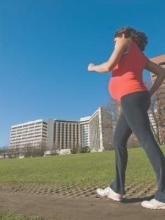Women with uncomplicated pregnancies should be encouraged to engage in aerobic and strength-conditioning exercises, including running, stationary cycling, and modified yoga, according to new recommendations from the American College of Obstetricians and Gynecologists.
Even women who were not active before becoming pregnant can start exercising during pregnancy, provided they consult with their physicians and ramp up their exercise gradually.
“Pregnancy should not be looked at as a state of confinement,” Dr. Raul Artal, chairman emeritus of the department of ob.gyn. at Saint Louis University and the lead author of the ACOG recommendations, said in a statement. “In fact, it is an ideal time for lifestyle modification. That is because more than any other time in her life, a pregnant woman has the most available access to medical care and supervision.”
The opinion from ACOG’s Committee on Obstetric Practice, which was released on Nov. 23, outlines safe and unsafe exercises during pregnancy and in the postpartum period, updating recommendations previously issued in 2002 and reaffirmed in 2009.
The updated recommendations differ from the relatively limited ones published by ACOG in 2002. Previously, ACOG recommended exercise only for women who were recreational or competitive athletes prior to pregnancy. And even in those cases, women were cautioned to “modify their usual exercise routines as medically indicated” and to avoid strenuous exercise in the second and third trimesters, especially women with “a history of or risk for preterm labor or fetal growth restriction.” Women who were not regularly physically active prior to their pregnancies were advised to consult with their physicians before beginning any exercise regimen (Obstet Gynecol 2002;99:171-3).
Now, women are encouraged to engage in some amount of physical activity during pregnancy, but physicians should conduct a thorough clinical evaluation before prescribing a specific exercise program to ensure the patient doesn’t have a medical reason to avoid exercise, according to ACOG.
The updated opinion advises that women should have an eventual goal of moderate-intensity exercise for at least 20-30 minutes per day on most or all days of the week. The “talk test” – whether a woman can carry on a conversation while exercising – is a good way to ensure that the exercise is not too intense.
In the updated recommendations, ACOG designates walking, swimming, stationary cycling, low-impact aerobics, modified yoga or pilates, running, jogging, racquet sports, and strength training as “safe” during pregnancy. But pregnant women should avoid contact sports, scuba diving, sky diving, “hot yoga” or “hot pilates,” and “activities with a high risk of falling” such as gymnastics and skiing, among others (Obstet Gynecol. 2015;126:e135-42).
Some absolute contraindications to aerobic exercise during pregnancy include hemodynamically significant heart disease, restrictive lung disease, incompetent cervix or cerclage, and multiple gestation at risk of premature labor, among others.
Obesity in pregnancy
ACOG also released updated clinical management guidelines for obesity in pregnancy, calling on ob.gyns. to calculate body mass index at the first prenatal visit and offer diet and exercise counseling.
The guidelines advise that obese women can have improved pregnancy outcomes by losing even just a little bit of weight prior to pregnancy, and losing weight between pregnancies can decrease the chances of obese women having “large-for-gestational-age neonates in a subsequent pregnancy” (Obstet Gynecol 2015;126:e112-26).
In addition, ACOG advises physicians to consider allowing a longer first stage of labor in obese women before performing a cesarean delivery for labor arrest. Mechanical thromboprophylaxis is recommended both before and after a cesarean in obese women.
While stillbirth rates are higher in obese pregnant women, ACOG did not make a recommendation for or against routine antenatal fetal surveillance in these women because of a lack of evidence showing clear improvement in pregnancy outcomes with surveillance.


